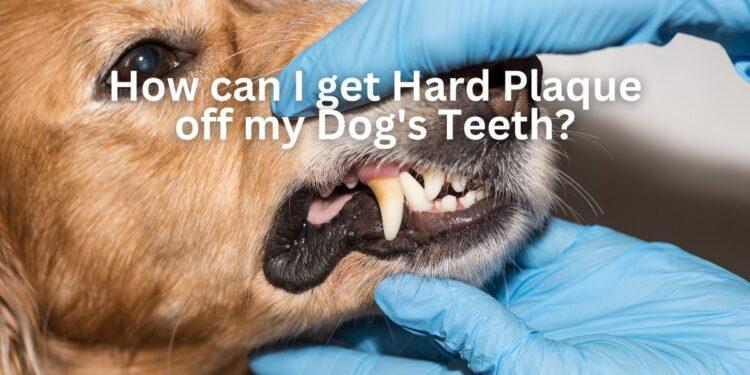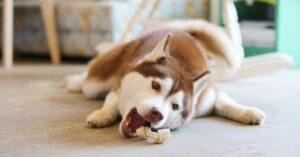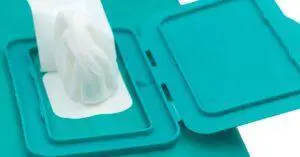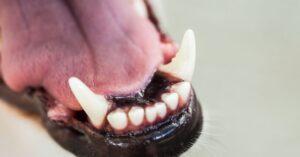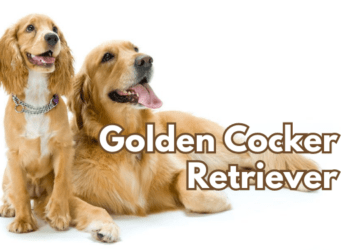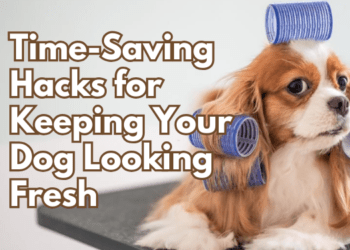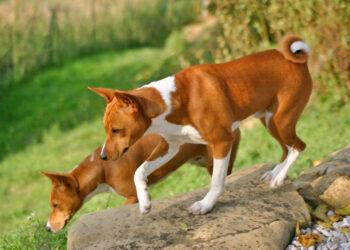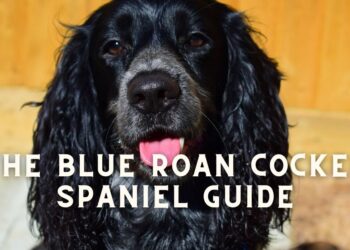Not all dogs are enthusiastic when it comes to cleaning teeth and I myself go through it almost every day. While my canines’ dentist has clearly advised me to regularly brush their whites to get hard plaque off my dog’s teeth, neither of my two Fidos give me an easy time.
Fed up, I researched ways over the Internet and while the majority of them were a total failure, in this blog I have compiled all the tips and tricks that could get your dog’s teeth sparkling like pearls. So, without further ado, let’s start.
Table of Contents
How can I get Hard Plaque off my Dog’s Teeth?
The best options that I personally tried to get hard plaque off my dog’s teeth include: using enzymatic meat-flavoured toothpaste, offering raw dog bone, dental treats, spraying dental sprays, wiping with dental wipes, and finally taking aid of coconut oil.
But before we divulge directly into the topic, let’s start by understanding how plaque is formed in the first place.
How does Plaque form?
Just like in humans, plaque formation in canines is a natural process. When the little ones eat food, their mouth secretes saliva which then mixes with the food, lubricating them for an easy transfer through the oesophagus. And while we humans make sure to wash our mouths afterwards, it is not quite possible to rinse a dog’s mouth efficiently after each meal.
This in turn serves as the perfect grounds for plaque formation. The saliva, food particles and bacteria cling to their teeth, forming a yellowish layer, medically known as plaque. And although plaque is fairly easy to deal with, avoiding them can quickly lead to the development of tartar, a brown buildup with severe repercussions.
So, how do I get rid of hard plaque off my dog’s teeth?
Using Enzymatic Meat-Flavoured Toothpaste
Now as I discussed earlier, both of my pups aren’t a fan of toothbrushes, but since the day I have started using enzymatic meat-flavoured toothpastes, the task has been a lot less difficult.
Unlike normal mint flavoured pastes, these pastes are specially made for canines and as their name suggests come in meat tastes. This could be lamb, chicken, turkey, beef, whatever you may like as there are literally numerous options available in the market.
So, I normally pour a little glob onto their toothbrush and let them sniff and lick it. Once both of the little devils are near enough, I give their pearly whites a gente brushing while maintaining a firm hand over them. This is to avoid them from escaping the discomfort of the brush and also to make sure that I am reaching all the nooks and crannies efficiently.
My final Ratings:
Comfort- ★★☆☆☆
Efficiency- ★★★★☆
Time Consumption- ★★☆☆☆
Safety- ★★★★★
Feasible for beginners- ★★☆☆☆
Offering Raw Dog Bone
The next go-to option for cleaning my dogs’ teeth is offering them raw dog bones. They absolutely love it and almost go crazy when they see me shuffling their favourite bag of dog bones.
Even more, these bones are safe for their consumption and serve as a great distraction when I am caught up with work. So every time I sit down to work, I offer them a single piece of raw dog bone, which they chew away happily. These bones come in many sizes and are hard enough not to break down into splinters and therefore cause choking hazards.
Similarly, thanks to their hard exterior, the continuous chewing helps smoothen the plaque and tartar buildup which gradually aids to their overall oral hygiene. However, making it a habit isn’t an ideal option, as you never know what goes into the making of these bones. And hence I stick to a two bones a week policy.
My final Ratings:
Comfort- ★★★★★
Efficiency- ★★★★☆
Time Consumption- ★★★☆☆
Safety- ★★☆☆☆
Feasible for beginners- ★★★★☆
Switching to Dental Treats
Like I stated above, I have my own skepticisms about raw dog bones, and therefore I often switch them with dental treats. Contrary to the bones, they come with a detailed ingredient list which helps me to better evaluate their effect on my pups’ health.
These dental treats are softer than raw dog bones, but have a rigid structure that helps scrape away the hard plaque off my dog’s teeth quite easily. They usually come in many sizes, shapes, and flavour variants with most of them backed by veterinarians. For instance, my pups often have the Pedigree Dentastix, Virbac Tartar Control Dog Chews, and the Blue Buffalo Wilderness Wild Bones Grain Free Dental Chews. This is supported by my dogs’ veterinarian, and hence may differ for others.
These treats are also affordable, don’t leave a stinky smell in their mouths, and easy to find at both online and offline stores.
My final Ratings:
Comfort- ★★★★★
Efficiency- ★★★★★
Time Consumption- ★★★☆☆
Safety- ★★★★☆
Feasible for beginners- ★★★★★
NOTE- Prior to introducing any kind of dental treats, always make sure to have a thorough consultation with your veterinarian. This could save you from emergency situations and expensive vet bills at the later stage.
Spraying Dental Sprays
I still remember the day when I had to rush my little pup to the vet’s chambers, only to be notified of his bad tartar situation. Before that I never really knew how bad plaque and tartar formation could be, but after a long treatment period, a huge bill, and recurring vet appointments soon the whole thing became crystal clear.
So, basically dental sprays are by far the second best plaque treatment that one can start. They are special solutions which when sprayed on the canine’s teeth and gums creates a microbial film preventing further worsening of the plaque and tartar condition. Apart from this, the film is also responsible for slowly dissolving the previous formations, helping the dog’s overall oral health come back to optimal conditions.
However, just like dog toothpastes, my canines are super wary of these dental sprays. Even holding the bottle will make them run away in full gear, making me have to chase behind them unless they are caught.
My final Ratings:
Comfort- ★★☆☆☆
Efficiency- ★★★★★
Time Consumption- ★★☆☆☆
Safety- ★★★★★
Feasible for beginners- ★★☆☆☆
NOTE- For best results, I combine brushing and spraying with canine dental sprays. This leaves my pups’ mouth smelling great and also sparkly clean for a long time.
Wiping with Dental Wipes
Another effective and tested way to get hard plaque off my dog’s teeth is using specialised canine dental wipes. These wipes have a smooth texture and are formulated with a mixture of essential components that keeps the dirty tartar and plaque miles away from my doggos’ whites.
Usually depending upon the smell and taste, my dogs resist a bit, but soon lie down peacefully or atleast sit near me, letting me clean their teeth and gums. With years of usage, I have found that upon wiping, the dental wipes release the components slowly, gradually dissolving the calcium deposits that may have clinged on causing the whole dreadful situation. What’s more??? They don’t sting like the brushes and are proven safe for canine usage.
But, unfortunately the one and only major disadvantage of using wipes is that they are very time taking. Unlike brushing or chewing raw bones, this procedure is a slow-one and hence may require days to weeks before showing any actual progress.
My final Ratings:
Comfort- ★★★★☆
Efficiency- ★★★★☆
Time Consumption- ★★★☆☆
Safety- ★★★★★
Feasible for beginners- ★★★★☆
Taking aid of Coconut Oil
Even though many of you may have already scrunched your noses, I have witnessed the wonders of using Coconut oil and hence adding this was a must. Coconut oil is widely known for its antimicrobial and anti-inflammatory properties, and proper usage of this to curb plaque and tartar related problems in canines has also been studied and proven by vets and researchers.
So, taking aid of this heavily researched fact and its easy availability at homes, I decided to give it a try. I took a soft cloth, dampening one end of it in the oil and then slowly and gently wiping my puppers’ teeth. Initially they were a bit shocked with the smell and taste, but contrary to the drama they do when using dental wipes they were surprisingly much more relaxed.
I continued this almost thrice a week, and although the change was slow, both of my doggos have super sparkly teeth with amazing pink gums. Even the vet was shocked to see such a transformation and advised me to keep continuing the process.
My final Ratings:
Comfort- ★★★★★
Efficiency- ★★★★★
Time Consumption- ★★★★☆
Safety- ★★★★★
Feasible for beginners- ★★★★★
NOTE- Make sure to do an allergy test before introducing coconut oil to your dog. Not all dogs respond the same to the oil and its components and therefore seeking extreme care is indeed necessary.
Final Thoughts
To end this blog, I would simply state that getting to know what works best to remove hard plaque or tartar from your dog’s teeth is a long and gradual process. You will have many successes and failures, but keeping your veterinarian side by side is an absolute need. But, if you want you can also try out my ways of removing hard plaque and let me know in the comment section how it turned out for you and your little fur ball.
You may also like:
Best Calming Supplement for Dogs
If you are a dog lover then, Subscribe to our weekly newsletters. No Spams!
